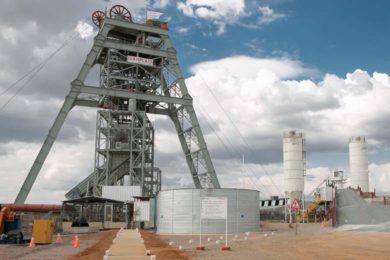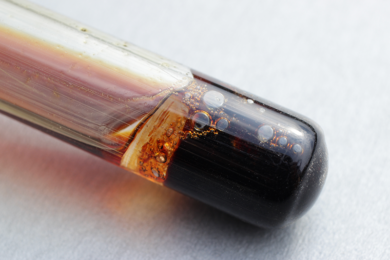Ivanhoe Mines’ Executive Chairman Robert Friedland, Chief Executive Officer Lars-Eric Johansson and Ivanplats’ Managing Director Dr Patricia Makhesha announced today that Platreef’s Shaft 1 has reached a depth of 750 m below surface and lateral development of the first mine access station now is underway.
The 750 m station on Shaft 1 will provide initial, underground access to the high-grade orebody, enabling mine development to proceed during the construction of Shaft 2, which will become the mine’s main production shaft. The mining zones in the current Platreef mine plan occur at depths ranging from approximately 700 m to 1,200 m below surface. Shaft 1’s 750 m station also will allow access for the first raise-bore shaft that will provide ventilation to the underground workings during the mine’s ramp-up phase.
The first of the mine’s planned fleet of mechanised, mobile, underground mining equipment – a small, 5.5 t LHD – has arrived on site and will be used for off-shaft station development work on the 750-, 850- and 950 m levels. People from Platreef’s surrounding host communities are being trained as operators of the LHD.
The LHD will be the first piece of mechanised, mobile equipment to be used underground on the northern limb of South Africa’s famous Bushveld Complex. The thick, flat-lying orebody at the Platreef Project is ideal for bulk-scale, mechanised mining. As underground development progresses, the mine plan calls for the addition of significantly larger mechanised mining equipment, such as 14 and 17 t LHDs and 50 t haul trucks.
Sinking of Shaft 1 will resume after the 750 m station is completed. The shaft is expected to intersect the upper contact of the Flatreef Deposit (T1 mineralised zone) at an approximate shaft depth of 783 m. As shaft sinking advances, two additional shaft stations will be developed at mine-working depths of 850 m and 950 m. Shaft 1 is expected to reach its projected, final depth of 980 m below surface in 2019.
“Soon we will be able to show our stakeholders and investors Flatreef’s remarkably thick, high-grade mineralised zones that will allow us to be at the forefront of safe, underground bulk mining,” said Friedland. “Our focus is to keep advancing the Platreef Project along its critical path. Our continued development of shafts 1 and 2 will provide access to the high-grade orebody and help to ensure that the project is able to meet the expected start-up of the first phase of the underground mine and concentrator.”
Friedland noted that the Platreef Project team and its South African sinking contractor, Aveng Mining, achieved a record monthly shaft-sinking rate of 54 m in March. The project also has attained 160 days without a lost-time injury, a notable achievement given the safety challenges that shaft-sinking operations encounter. Ivanhoe says it remains committed to its workplace objective of an environment that causes zero harm to employees, contractors, sub-contractors and consultants.
“We believe that the unique characteristics of our Flatreef Discovery offer us the opportunity for a highly-mechanised and safe working environment for a new generation of skilled and trained South African workers.” Approximately 40% of Platreef’s shaft-sinking team now is comprised of employees from local communities who had no previous mining experience. New employees receive intensive, on-site training for underground mining and complete a workplace-safety induction program.
In July 2017, Ivanhoe issued an independent, definitive feasibility study (DFS) for Platreef that covers the first phase of production at an initial mining rate of 4 Mt/y. The DFS estimated that Platreef’s initial, average annual production rate will be 476,000 oz of platinum, palladium, rhodium and gold, plus 21 Mlb of nickel and 13 Mlb of copper.
“Many investors don’t realise that, in addition to Platreef being projected to become one of Africa’s largest producers of platinum-group metals, the mine also is expected to be a significant producer of nickel and copper — two metals that are fundamental components for the electric-vehicle revolution,” said Friedland.
“Nickel is trading at three-year highs, due in part to the increased demand for metals needed for electric-vehicle batteries. There is a growing market realisation that the new era of electric vehicles will be a disruptive, long-term force that will have a material impact on certain key metals — such as nickel, copper and cobalt — as early as 2020.” Ivanhoe is working with potential concentrate-processing partners to study ways to incorporate an upgrading step to produce battery-grade nickel sulphate.
The first two surface blasts for Shaft 2’s box cut were successfully completed earlier this month; four additional blasts are planned. The blasting will enable the excavation of the box cut to a depth of approximately 29 m below surface and the construction of the concrete hitch (foundation) for the 103 m tall concrete headgear (headframe) that will house the shaft’s permanent hoisting facilities and support the shaft collar. Excavation of the box cut is expected to be completed by the end of the year.
Shaft 2, to be located approximately 100 m northeast of Shaft 1, will have an internal diameter of 10 m,will be lined with concrete and sunk to a planned, final depth of more than 1,104 m below surface. It will be equipped with two 40 t rock-hoisting skips with a capacity to hoist a total of 6 Mt/y of ore – the single largest hoisting capacity at any mine in Africa. Headgear for the permanent hoisting facility was designed by South Africa-based Murray & Roberts Cementation.










